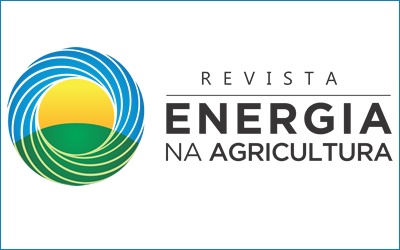INFLUÊNCIA DA ADUBAÇÃO NITROGENADA, IDADES DE CORTE DA PLANTA E PRÉ-TRATAMENTOS DA FIBRA SOBRE A PRODUÇÃO DE ETANOL DE CAPIM-ELEFANTE CULTIVADO EM SOLOS DE CERRADO
DOI:
https://doi.org/10.17224/EnergAgric.2020v35n1p62-79Resumo
INFLUÊNCIA DA ADUBAÇÃO NITROGENADA, IDADES DE CORTE DA PLANTA E PRÉ-TRATAMENTOS DA FIBRA SOBRE A PRODUÇÃO DE ETANOL DE CAPIM-ELEFANTE CULTIVADO EM SOLOS DE CERRADO
PAULO RICARDO AMÉRICO GLÓRIA1, FLÁVIA LUCILA TONANI DE SIQUEIRA2, GUILHERME BENKO DE SIQUEIRA3, WALYSSON BERNARDO RODRIGUES SANTOS4, ITANA NEIVA BATISTA5
1 Programa de Pós-Graduação em Agroenergia, Universidade Federal do Tocantins, Avenida NS – 15, ALCNO – 14, Quadra 109 Norte, Plano Diretor Norte, CEP 77001-090, Palmas, TO, Brasil. pauloricardoagro23@gmail.com
2 Departamento de Agroenergia, Programa de Pós-Graduação em Agroenergia, Universidade Federal do Tocantins, Avenida NS – 15, ALCNO – 14, Quadra 109 Norte, Plano Diretor Norte, CEP 77001-090, Palmas, TO, Brasil. flaviatonani@mail.uft.edu.br
3 Departamento de Agroenergia, Programa de Pós-Graduação em Agroenergia, Universidade Federal do Tocantins, Avenida NS – 15, ALCNO – 14, Quadra 109 Norte, Plano Diretor Norte, CEP 77001-090, Palmas, TO, Brasil. guibenko@uft.edu.br
4 Programa de Pós-Graduação em Agroenergia, Universidade Federal do Tocantins, Avenida NS – 15, ALCNO – 14, Quadra 109 Norte, Plano Diretor Norte, CEP 77001-090, Palmas, TO, Brasil. walysonbernardo@gmail.com
5 Programa de Pós-Graduação em Agroenergia, Universidade Federal do Tocantins, Avenida NS – 15, ALCNO – 14, Quadra 109 Norte, Plano Diretor Norte, CEP 77001-090, Palmas, TO, Brasil. itananeiva@gmail.com
RESUMO: O experimento avaliou o efeito de diferentes níveis de adubação nitrogenada (0, 50, 100 e 150 kg ha-1) e idades de corte da planta (100, 130 e 160 dias após o plantio) sobre a produtividade do capim-elefante “BRS Canará” e a influência de diferentes pré-tratamentos da fração fibrosa (um, utilizando autoclavagem em meio ácido, e o outro, em meio ácido seguido de básico) sobre o rendimento em etanol estimado pela hidrólise da fibra. O delineamento experimental utilizado foi inteiramente casualizado em esquema de parcelas sub subdivididas. A produtividade não foi influenciada pelos diferentes níveis de adubação nitrogenada, entretanto, na medida em que as idades de corte avançaram, foi observado incremento significativo (P<0,05) na produção do capim-elefante. Os fatores experimentais não interagiram entre si significativamente (P>0,05), exceto para estimativa de rendimento de etanol em L.t-1 de matéria seca original nas variáveis idades de corte da planta e pré-tratamentos. Os níveis de nitrogênio não influenciaram o rendimento em etanol. O corte realizado aos 100 dias apresentou maior rendimento em L.t-1 de matéria seca pré-tratada (93,67 litros), já o corte aos 160 dias proporcionou o maior rendimento em L ha-1 (426,09 litros). O pré-tratamento ácido/base proporcionou maior rendimento em L.t-1 de matéria seca pré-tratada (114,41 litros), mas não foi observado efeito significativo (P>0,05) entre pré-tratamentos quando o rendimento foi expresso em L ha-1.
Palavras-chave: biomassa, etanol, nitrogênio, corte, pré-tratamentos.
INFLUENCE OF NITROGEN FERTILIZATION, PLANT CUTTING AGES AND FIBER PRE-TREATMENTS ON THE PRODUCTION OF CAPIM ELEPHANT ETHANOL CULTIVATED IN CLOSED SOILS
ABSTRACT: The experiment evaluated the effect of different levels of nitrogen fertilization (0, 50, 100 and 150 kg ha-1) and cutting ages (100, 130 and 160 days after planting) on elephant grass “BRS Canará” productivity and the influence of different pre treatments of fibrous fraction (one, using autoclaving in a medium acid and the other, in a medium acid followed by basic) on the ethanol yield estimated by the fiber hydrolysis. The experimental design used was completely randomized in a subdivided plot scheme. The productivity was not influenced by the different levels of nitrogen fertilization, however, as the cutting ages advanced, a significant increase (P <0.05) in the production of elephant grass was observed. The experimental factors did not interact with each other significantly (P> 0.05), except for estimation of ethanol yield in L.t-1 of original dry matter in the plant cutting age and pretreatment variables. Nitrogen levels did not influence ethanol yield. The cut made at 100 days showed the highest yield in L.t-1 of pre-treated dry matter (93.67 liters), while the cut at 160 days provided the highest yield in L ha-1 (426.09 liters). The acid / base pretreatment provided the highest yield in Lt-1 of pre-treated dry matter (114.41 liters), but no significant effect (P> 0.05) was observed between pretreatments when the yield was expressed in L ha-1.
Keywords: biomass, ethanol, nitrogen, cutting, pre-treatments.
Downloads
Publicado
Como Citar
Edição
Seção
Licença
Esta revista proporciona acesso publico a todo seu conteúdo, seguindo o princípio que tornar gratuito o acesso a pesquisas gera um maior intercâmbio global de conhecimento. Tal acesso está associado a um crescimento da leitura e citação do trabalho de um autor. Para maiores informações sobre esta abordagem, visite Public Knowledge Project, projeto que desenvolveu este sistema para melhorar a qualidade acadêmica e pública da pesquisa, distribuindo o OJS assim como outros software de apoio ao sistema de publicação de acesso público a fontes acadêmicas.





